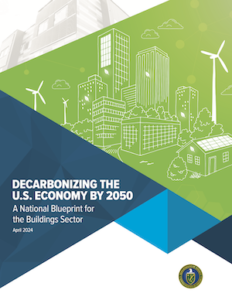
U.S. releases national buildings decarbonization plan
April 3, 2024 | By HPAC Magazine
Strategy outlines pathways to reduce emissions by 90% in the buildings sector by 2050.
 As Canadians wait for the forthcoming Canada Green Buildings Strategy to be delivered by the federal government, the U.S. Department of Energy (DOE) has just released Decarbonizing the U.S. Economy by 2050: A National Blueprint for the Buildings Sector, a federal plan to reduce greenhouse-gas (GHG) emissions from buildings by 65% by 2035 and 90% by 2050.
As Canadians wait for the forthcoming Canada Green Buildings Strategy to be delivered by the federal government, the U.S. Department of Energy (DOE) has just released Decarbonizing the U.S. Economy by 2050: A National Blueprint for the Buildings Sector, a federal plan to reduce greenhouse-gas (GHG) emissions from buildings by 65% by 2035 and 90% by 2050.
The Blueprint is the first sector-wide strategy for building decarbonization developed by the U.S. federal government.
“America’s building sector accounts for more than a third of the harmful emissions jeopardizing our air and health,” said U.S. Secretary of Energy Jennifer M. Granholm in a release. “As part of a whole-of-government approach, DOE is outlining for the first time ever a comprehensive federal plan to reduce energy in our homes, schools, and workplaces—lowering utility bills and creating healthier communities while combating the climate crisis.”
According to the U.S. Census Bureau Household Pulse Survey, one in five Americans lives in a household that is at least one month behind on its energy bills. To address this issue, the Blueprint emphasizes affordability through reduced energy and technology costs, as well as measures that would help make communities more resilient to power outages and extreme weather events.
The Blueprint sets four strategic objectives:
- Increasing building energy efficiency
- Accelerating onsite emissions reductions
- Transforming the interactions between buildings and the electricity grid
- Minimizing the emissions from producing, transporting, installing, and disposing of building materials
Each objective has performance targets and market, policy, and technology milestones to reach by 2035 and 2050.
As part of its call to action, the report looks at steps the federal government must look at to move forward, including: reduce the cost of heat pumps, improve public awareness of low-carbon solutions and their benefits, provide technical assistance and workforce training, and lead by example with federal facility decarbonization.
Those actions include funding research and development to develop lower-cost technologies, expanding markets for low-carbon technologies, providing direct funding and financing, and supporting the development and implementation of emissions-reducing building codes and appliance standards.
In addition, DOE is focused on innovation in three areas: building upgrades, efficient electrification, and smart controls.
DOE’s approach strives to advance scalable technologies and installation solutions for affordable-housing residents while expanding workforce capabilities at the state and local levels. The report also recognizes the employment opportunities the transition represents. Acknowledging that the need to increase the pace of building retrofits and heat pump conversions to decarbonize buildings has the potential to increase the number of high-quality energy efficiency jobs, which also offers an opportunity to train underrepresented individuals for these jobs. “Jobs in building construction; renovation; and HVAC tend to have low educational barriers-to-entry and are likely to be resistant to outsourcing and automation, so they represent an opportunity for long-term, high-quality employment.”

Residential space heating: to convert 100 million homes to heat pumps by 2050, the current pace of conversion needs to increase tenfold from 500,000 conversions per year to 5 million conversions per year by 2030. (source: A National Blueprint for Decarbonizing the Buildings Sector)
The report also sees the challenge in retrofitting residential space heating in the 100 million homes across the U.S. At the current pace of conversion to heat pumps (about 500,000 per year), it will take 200 years to transition all homes to non-fossil-fuel heating.
Despite positive market trends—last year Americans purchased 4 million heat pumps, surpassing gas furnace sales for the first time—this progress is still not enough to meet the massive scale of the deployment challenge which will require up to a 10-times increase in the current rate of residential heat pump conversions by 2030.
DOE’s Affordable Home Energy Shot, which aims to reduce the upfront cost of upgrading a home by at least 50% and reduce energy bills by 20% within a decade, is one program designed to accelerate progress toward the emissions-reduction targets established in the Blueprint.
The full report can be downloaded here: energy.gov




